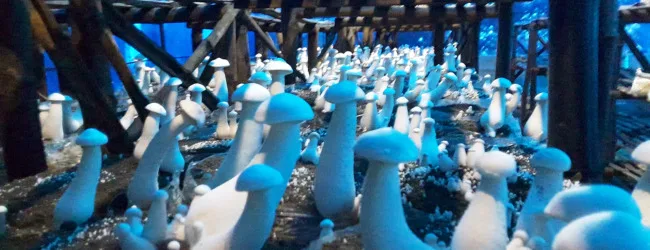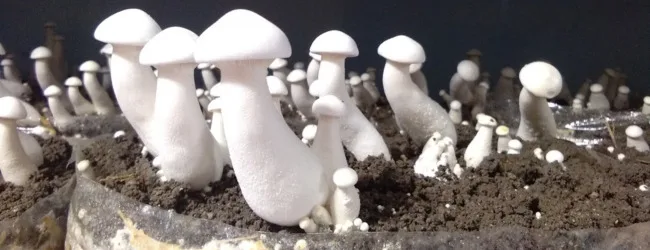Table of contents
- What is a Milky Mushroom?
- Why Milky Mushroom Farming is Booming in 2025
- Nutritional Value of Milky Mushroom (Per 100g)
- Step-by-Step Guide to Milky Mushroom Farming in India
- Milky Mushroom Farming Cost & Profit Analysis (Per 100 Bags)
- Packaging & Marketing Tips
- Training & Support in India
- Comparison: Milky vs Other Mushrooms
- Conclusion
- Frequently Asked Questions (FAQs)
Milky mushroom is quickly emerging as India’s next big superfood in 2025, thanks to its rich protein content, immunity-boosting properties, and high profitability. For new-age farmers and agri-preneurs, milky mushroom farming offers a low-cost, high-return opportunity with a growing market demand across urban and rural India.
What is a Milky Mushroom?

Milky mushroom (Calocybe indica) is a tropical, edible white mushroom known for its:
- Thick white stalk and cap.
- High nutritional value (rich in protein, vitamins B & D, and fibre).
- Easy-to-grow nature, especially in warm and humid climates like India.
Why Milky Mushroom Farming is Booming in 2025
| Reason | Details |
|---|---|
| High Demand | Rise in vegan & healthy food trends. |
| Low Setup Cost | Cheaper than button or oyster mushroom farming. |
| Suitable Climate | Ideal for most Indian states – needs 25–35°C. |
| Good Shelf Life | Stays fresh up to 7–10 days under refrigeration. |
| High Returns | ₹150–₹250 per kg selling price in local markets. |
💡 Pro Tip: If you want to start a Business but have too many doubts, connect with a Business expert from Boss Wallah for guidance – Check Out
Nutritional Value of Milky Mushroom (Per 100g)
| Nutrient | Amount |
|---|---|
| Protein | 3.9 g |
| Fiber | 1.8 g |
| Vitamin B2 | 0.35 mg |
| Vitamin D | 10.3 IU |
| Carbohydrates | 4.7 g |
| Fat | 0.3 g |
| Calories | 30 kcal |
Note: Its anti-inflammatory and antioxidant properties make it a superfood in 2025!
ALSO READ | Indoor Mushroom Farming in India: A Comprehensive Guide (2025)
Step-by-Step Guide to Milky Mushroom Farming in India

1. ✅ Site Selection and Setup
- Requires a well-ventilated shed or indoor grow room.
- Opt for a temperature range of 25–35°C and humidity around 70–80%.
- Low-light or dimly lit areas work best.
2. 🧱 Infrastructure Required
| Item | Estimated Cost (₹) |
|---|---|
| Polyhouse/Shed (200 sq. ft.) | ₹15,000 – ₹20,000 |
| Racks/Trays | ₹5,000 |
| Water sprayer/humidifier | ₹3,000 |
| Spawn and substrate | ₹2,000 |
| Misc. (gloves, bags, thermometers) | ₹1,000 |
| Total (Basic setup) | ₹25,000 – ₹30,000 |
3. 🌾 Substrate Preparation
- Use paddy straw or wheat straw.
- Cut into 3–5 cm pieces, soak for 6–8 hours.
- Pasteurise using hot water (~65°C) for 1 hour.
- Drain and cool the straw.
4. 🍄 Spawning Process
- Use quality milky mushroom spawn from a certified supplier.
- Fill polypropylene bags with 3–4 kg substrate.
- Add spawn in layers while filling the bags.
- Tie the bags tightly and poke holes for aeration.
5. 🌡️ Incubation
- Keep the bags in a dark room for 15–20 days.
- Maintain temperature: 30–35°C and 75% humidity.
- Mycelium (white thread-like growth) will colonise the substrate.
6. ☀️ Fruiting Stage
- Shift bags to a humid room with low light.
- Cut open the bags once full white mycelium is visible.
- Spray water 3–4 times daily to maintain moisture.
7. 🍽️ Harvesting
- Mushrooms are ready for harvest in 30–35 days.
- Pick when the caps are fully expanded.
- Avoid overwatering before harvest to extend shelf life.
Milky Mushroom Farming Cost & Profit Analysis (Per 100 Bags)
| Item | Cost (₹) |
|---|---|
| Paddy Straw | 600 |
| Spawn | 1,200 |
| Bags & Utilities | 500 |
| Labor | 1,000 |
| Misc. | 200 |
| Total Cost | ₹3,500 |
- Yield: 40–50 kg mushrooms
- Market Price: ₹180/kg (avg)
- Revenue: ₹7,200 – ₹9,000
- Profit (Net): ₹3,700 – ₹5,500
💡 Highlight: Milky mushroom offers nearly 100–150% profit margin in just one month cycle.
ALSO READ | Mushroom Farming Loan and Subsidy: Top 10 Loans to Launch Your Business
Packaging & Marketing Tips
- Use perforated plastic trays or cartons for bulk.
- Brand your produce if selling in urban markets.
- Sell through:
- Local vegetable vendors
- Online grocery platforms
- Farmer markets or organic food expos
Training & Support in India

- Indian Council of Agricultural Research (ICAR)
- Krishi Vigyan Kendras (KVKs)
- State Agriculture Universities (SAUs)
- Online platforms like AgriFarming, YouTube tutorials, and AgriStartups
Comparison: Milky vs Other Mushrooms
| Feature | Milky Mushroom | Button Mushroom | Oyster Mushroom |
|---|---|---|---|
| Climate Need | Tropical | Cold | Tropical |
| Shelf Life | 7–10 days | 2–3 days | 1–2 days |
| Price | High (₹150–₹250/kg) | Medium (₹100–₹180/kg) | Low (₹70–₹120/kg) |
| Taste | Mild & chewy | Earthy | Slightly nutty |
Need Expert Guidance?
Starting a business can be challenging, but you don’t have to do it alone! At Boss Wallah, our 2,000+ business experts are ready to provide valuable insights and guidance. Whether you need help with marketing, finance, sourcing, or any other area of any business, our business experts are here to help you succeed
Confused about Which Business to Start?
Want to start your own business but unsure which one to choose? Explore Boss Wallah, where you’ll find 500+ courses by successful business owners, featuring practical, step-by-step guides on starting and growing various businesses.
Find your perfect business idea today
Conclusion
Milky mushroom farming in 2025 is not just a trend—it’s a profitable, sustainable, and health-forward venture. With low investment, fast returns, and rising market demand, it’s one of the top agri-businesses for rural and urban farmers alike. Whether you’re a beginner or an experienced grower, milky mushroom offers a reliable pathway to green income and healthy living.
Frequently Asked Questions (FAQs)
25–35°C is best suited for healthy growth.
Starting cost ranges between ₹25,000 to ₹30,000 for a small setup.
From ICAR centres, KVKs, or reputed spawn suppliers online.
About 30–35 days from spawning to harvesting.
Yes! They are ideal for indoor farming with controlled conditions.
Profit margins range from 100–150% per crop cycle.
They stay fresh for 7–10 days in the refrigerator.
Green mould, bacterial rot, can be prevented with hygiene and ventilation.
Through local markets, restaurants, supermarkets, and online platforms.
Yes, many states provide subsidies under horticulture/agriculture schemes.


